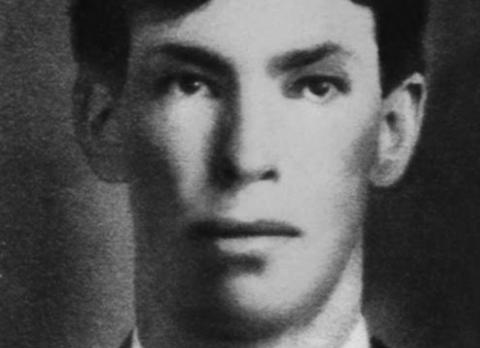 |
Canku Ota
|
 |
|
(Many Paths)
|
||
|
An Online Newsletter
Celebrating Native America
|
||
|
November 2015 - Volume
13 Number 11
|
||
|
|
||
|
Aboriginal Star Hailed
As 'Pioneer' By Soccer Hall Of Fame
|
||
|
by Duncan McCue - CBC
News reporter
|
||
|
credits: {credits}
|
|
Harry Manson transcended racial prejudice on the soccer pitch at turn of 20th century
Harry Manson broke racial barriers as a First Nations athlete in British Columbia at the turn of the 20th century. Grandson Gary Manson's dining room is crowded with soccer trophies: stacked on shelves, on top of the fridge, wedged in between hand drums and beaded prayer banners. They are all products of his decades coaching men's soccer teams from the Snuneymuxw First Nation on Vancouver Island. "Soccer is in our blood," said Manson. "It's what we do." But, he's thrilled to be accepting an extraordinary award in Ontario this weekend, honouring his late grandfather’s athletic achievements over a hundred years ago. The national Soccer Hall of Fame is saluting Harry Manson as a "pioneer" of the game in Canada, a speedy goal scorer who transcended racial prejudice to lead his people to a string of victories on the soccer pitch at the turn of the 19th century.
Amongst the Snuneymuxw, he was known by his traditional name: Xul-si-malt. In the 1890s, the lifestyle of the Snuneymuxw was undergoing profound transformation. Scores of labourers drawn by coal mines turned Nanaimo into a sprawling settlement and bustling port city, but the Snuneymuxw were mostly segregated to their small village on the beach, marked with longhouses and totem poles. Racism was socially acceptable at the time, as many settlers considered aboriginal people less than human. But, known by his Christian name, Harry Manson, and spurred by his love of the game, Xul-si-malt became a trailblazer in a sport still in its infancy in the new colony. The story of Harry Manson, the first aboriginal person to be inducted into the Soccer Hall of Fame - Nov 7, 201424:58 They were the first aboriginal players to compete in a provincial championship, playing side-by-side with their white peers. Manson scored, in a losing effort. In 1903, Manson was named to the provincial all-star team. The next year, he captained an all-Snuneymuxw squad called the Indian Wanderers to a Nanaimo city championship, despite jeers from white fans, some shouting "Kill the savages!" "I try to imagine what it’s like being on a field in Ladysmith with a couple thousand people on the sidelines. They're all white, it’s a very intimidating atmosphere, and they're all hurling abuse at these indigenous players," said Robert Janning, an amateur soccer historian. Manson helped to create an all-aboriginal team to compete in the city soccer league, where his talent stood out. In 1898, in a bid to win a provincial championship, the all-white
Nanaimo team turned to two players from the Snuneymuxw First Nation:
Manson and James Wilkes.
"Despite all these obstacles of segregation that were being constructed around him, he was breaking a colour barrier in sports long before Jesse Owens or Jackie Robinson did so in the U.S.," said Janning. By 1907, Manson and three other Snuneymuxw were starters for the Nanaimo team, again playing for the West Coast's biggest soccer prize: the Challenge Cup. Final score: Nanaimo 4-1. All the goals were from Snuneymuxw players. But when it came to the celebratory banquet, Manson and the other Snuneymuxw players weren't invited.
Harry Manson died tragically in 1912. He was just 30 years old. After heading into town to seek medicine for his sick infant, he was run over by a train. A coroner later found the railroad company not at fault, because one witness testified Manson seemed intoxicated as he attempted to leap onto a rail car. Manson's story was long lost, until Robert Janning began researching a history of soccer's roots in British Columbia. Janning was struck by the recurring mention of Manson in archival records and newspaper reports. When he tracked down the Manson family, they knew little about their ancestor's soccer success; the only historical record they had was the coroner's report detailing Manson's demise. "For the longest time, I wondered who our heroes were, and why we didn't have them," said Dean Manson, one of Xul-si-malt's many grandchildren. "Now, I have a grandfather who's a hero. He's always been there, but it was never spoken of how great he was in soccer." Janning and the Manson family are now fundraising to commemorate Harry Manson’s legacy with an annual soccer competition for at-risk youth. They plan to hold the inaugural tournament in June 2015 in Nanaimo.
Duncan McCue has been a reporter for CBC News for over 15 years. His news and current affairs pieces are featured on CBC's The National. McCue was awarded a Knight Fellowship at Stanford University in 2011, where he created an online guide for journalists called Reporting in Indigenous Communities. Duncan is Anishinaabe, a member of the Chippewas of Georgina Island First Nation in southern Ontario. |
|||||||
|
|
|
|
||
|
|
||
| Canku Ota is a free Newsletter celebrating Native America, its traditions and accomplishments . We do not provide subscriber or visitor names to anyone. Some articles presented in Canku Ota may contain copyright material. We have received appropriate permissions for republishing any articles. Material appearing here is distributed without profit or monetary gain to those who have expressed an interest. This is in accordance with Title 17 U.S.C. Section 107. | ||
|
Canku Ota is a copyright ©
2000 - 2015 of Vicki Williams Barry and Paul Barry.
|
||
 |
 |
|
|
The "Canku
Ota - A Newsletter Celebrating Native America" web site and
its design is the
|
||
|
Copyright ©
1999 - 2015 of Paul C. Barry.
|
||
|
All Rights Reserved.
|
||

.jpg)
.jpg)